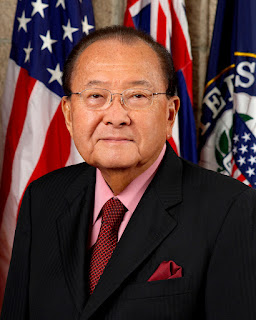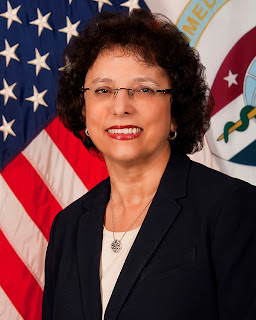Historic Influences Help Propel USU’s Graduate School of Nursing to its 30th Anniversary
USU’s Graduate School of Nursing Celebrates Three Decades of Service to Nation
May 9th, 2023 By Ian Neligh
What began with a heroic act on the battlefields of World War II helped create one of the nation’s premier graduate schools of nursing.
This year the Uniformed Services University of the Health Sciences (USU) Daniel K. Inouye Graduate School of Nursing (GSN) celebrates its 30th anniversary.
For three decades, the school has provided the nation with the highest quality advanced practice nurse clinicians, scholars, and scientists, uniquely prepared to advance healthcare in military and federal systems.
Founded in 1993, USU’s then-president, Dr. James Zimble proposed establishing a Graduate School of Nursing to address national concerns over the lack of clinical specialists, nurse practitioners, and nurses with advanced graduate education and training. Over the past 30 years, the school has expanded, offering three degree options: a Master of Science in Nursing, a Doctor of Nursing Practice, and a Doctor of Philosophy in Nursing Science.
But in those early days, the GSN may not have come to be without the tireless support of a highly decorated combat veteran and lifelong advocate of nursing.
World War II
Sen. Daniel K. Inouye was born in Honolulu, Hawaii, in 1924. Eighteen years later, as a medical aid, he was among the first to treat the wounded in the aftermath of the attack on Pearl Harbor. Inouye dropped out of pre-medical education to join the 442nd Regimental Combat Team, a unit comprised of soldiers of Japanese ancestry. The military unit became one of the most highly decorated in U.S. history and Inouye himself would go on to be awarded the Congressional Medal of Honor, the Distinguished Service Cross, the Bronze Star, and Purple Heart with Cluster.
 |
Wounded during World War II, Sen. Daniel K. Inouye became a lifelong advocate of nursing, which ultimately led to the establishment of the GSN in 1993. (Courtesy photo) |
According to GSN Associate Dean for Academic Affairs Dr. Diane Seibert, Inouye often told the story of how, when he was gravely injured, a military physician went from bed to bed assessing the wounded soldiers to identify who could and could not be saved. At each bedside, the doctor would nod or shake his head and move on to the next soldier, followed by a nurse and a chaplain who performed the last rites. The doctor looked at Inouye, shook his head, and was prepared to move on.
“Apparently when the surgeon came up to his bed he shook his head, but the nurse intervened and said ‘No — I think this one is going to make it,’” Seibert says. A nurse later taught Inouye how to find his independence with only one arm. “A nurse said, ‘You’re going to have to figure this out. You can do this.’”
These two experiences made a deep and lasting impact on Inouye, who ultimately paid it forward to the nursing profession and, eventually, to USU.
Inouye recovered and ended up practicing law, then became a representative in Congress when Hawaii became the 50th state. Inouye later won election to the U.S. Senate.
Inouye was a champion for nurses, which led to the establishment of the GSN in 1993.
“The University existed but there were no nursing programs,” Seibert says. “By that time, Senator Inouye had enough seniority in Congress that he appropriated money to start a nursing program at USU, declaring that he was ‘going to give the university $3 million, you will start a graduate school of nursing.’”
The school was eventually named in his honor.
“We couldn’t name anything until he was deceased – that was one of his requirements,” Seibert says, “but we named the school after him not long after he died (in 2012) because he was passionate about healthcare but more importantly, for us, he was passionate about nursing.”
’An icon in nursing’
The GSN’s foundation was built upon several significant moments in U.S. history.
In 1937, a German airship, the Hindenburg, horrifically exploded over Lakehurst, New Jersey. During an interview years later, Abdellah recalled witnessing the event at age 18, seeing people jump from the burning zeppelin. She didn’t know then how she could help them, but the experience forever changed the course of her life. She took a vow to learn nursing and, many years later, she would be inducted into the American Nurses Association Hall of Fame for her many significant contributions to the field.
“She was an icon in nursing,” Seibert said. “Dr. Zimble asked her to lead this new program and she immediately began gathering together a team to build the Graduate School of Nursing.”
Seibert arrived at the GSN in 1995, just in time to see the first full class of nursing students graduate. She remembers that, in those early years, the university didn’t have enough space for the nursing programs, so the faculty were originally given offices on Rockville Pike, on the third floor of the “Chili’s” Building (a Chili’s restaurant was on the ground floor).
The University found larger rental space on the ninth floor of a building in Silver Spring when the faculty got too large for that location, and arranged a shuttle to transport faculty to and from campus. The GSN faculty finally joined the rest of the USU community in May 2008 after Building E was completed.
Lessons from the past inform the future
Air Force Lt. Col. Regina Aune arrived at the GSN in the early 1990s, serving as its Commandant and chair of the Department of Nursing Research. But back in 1975, Aune was a junior flight nurse with three years’ experience assigned to Clark Air Base in the Philippines.
The Vietnam war was under way and the order to evacuate had just been given. Aune flew to Saigon to be part of “Operation Babylift” – the evacuation of 2,000 orphans, many of them Amerasian children, to the U.S. After the C-5 was filled with children, and was more than 18 miles from Saigon and 23,000 ft. in the air, an explosion took place, followed by rapid decompression. The plane crash-landed in a rice paddy. Aune suffered a broken leg, broken back, was covered in blood and mud, yet she continued to evacuate the casualties until she fainted.
The following year, Aune received the Cheney Award for her heroic efforts. The Cheney Award, named for 1st Lt. William Cheney, was established in 1927, and is awarded to an airman for an act of valor, extreme fortitude or self-sacrifice in a humanitarian interest, performed in connection with aircraft.
Aune was the first female in its history to receive the award and to date is one of only three female recipients. She would then go on to serve on the faculty of the GSN, sharing her experiences from Operation Babylift with students as one of many lessons-learned throughout her career, helping to shape them as future nursing leaders.
‘The tipping point’
Seibert admits that there was some initial resistance to the creation of the GSN, even from federal nursing leaders, because there were many civilian programs educating and training nurses, but all that changed after Sept. 11, 2001.
She recalls the shock of seeing student clinical logs from that morning; second patient was a “42-year-old Marine with a headache” and the third patient was “52-year-old with third-degree burns, fell through two stories of a building” as students helped care for the wounded after terrorists crashed American Airlines Flight 77 into the southwest corner of the Pentagon.
“That day changed the curriculum forever as we transitioned from a peacetime, Cold War curriculum to a curriculum designed to prepare graduates for war. A war that lasted over 20 years,” Seibert says. “The military Service Chief Nurses regularly ask us to refine and reshape our curriculum to ensure that our graduates are prepared to deploy within 60 days of graduation — especially the CRNAs who were going downrange with whatever skills we’ve given them.”
Seibert said nurses come to the GSN well-prepared in their military and nursing careers and the curriculum transforms them into independent providers prior to returning them back to assume new roles in the same system. As new needs emerge, the GSN adapts and expands, adding new content based on the evolving needs of the military branches.
“I think the Services started to see the value when those wars kicked off,” Seibert said. “I want to say probably the tipping point where the Services went from reluctantly sending us people … was probably just after Sept. 11.”
“I came to USU understanding and appreciating the military and military nurses,” says Seibert, who grew up in a military family and was an ROTC cadet before joining the Air Force. “This is my community, so was I surprised that the GSN is able to create providers who are unique and special? Not really — because I believe that nurses who choose the military are a special kind of nurse. It has been my privilege and pleasure to work with this community because I feel like I am giving back to my community.”
The Vision
 |
Dean of the GSN, Dr. Carol Romano (Photo credit: Tom Balfour, USU) |
The school has been designated as a Center of Excellence by the National League for Nursing (NLN) for Excellence twice: in the categories of “Promoting the Pedagogical Expertise of Faculty” (2021-2025) and “Enhancing Student Learning and Professional Development” (2020-2024). There are fewer than 70 nursing schools across the country that have achieved NLN Center of Excellence designation in any category.
In addition, US News & World Report “2023 Best Graduate Nursing School” rankings listed the GSN Doctor of Nursing Practice Program (#21), in the top 5% of the 604 accredited schools surveyed and its CRNA program has consistently ranked in #4 in the nation.
According to Dr. Carol Romano, dean of the GSN, those levels of recognition are due to the excellence of the school’s faculty, students, and staff. The inspiration and influence from those who have been a part of the GSN’s history over the past three decades is also a major contributing factor in its success. Romano reports that the GSN’s mission is being actualized and its goals are being achieved: the Daniel K. Inouye Graduate School of Nursing now celebrates 30 years of operation with the pride of having the highest quality of nurse clinicians, scholars, and scientists educated and trained to meet the nation’s ever-changing needs.







